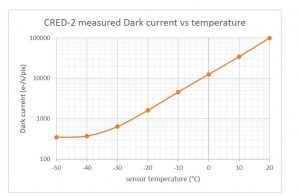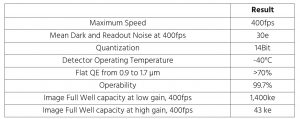Breaking the speed limit
Ultra high speed SWIR InGaAs camera with up to 400fps
The C-Red 2 is an ultra high speed low noise InGaAs SWIR camera. The camera integrates a 640×512 InGaAs PIN Photodiode detector with pixels of 15µm allowing performances up to 400fps with a read out noise below 30 electrons.

Figure 1 | Dark current measurement from the C-Red 2 SWIR-camera which achieves up to 400fps. The mean
dark current is multiplied by a factor of 2 every ~7°C in the -40 to +20°C region. (Figure: First Light Imaging S.A.S.)
Short Wave InfraRed Imaging offers incredible imaging possibilities. Indeed, in this particular wavelength from 0.9 to 1.7m not visible to the human eye, SWIR cameras detect phenomena thanks to the reflection or the absorption of the light by the object, whereas visible cameras are blind. Most of SWIR cameras are based on InGaAs (Indium Gallium Arsenide) detectors, which have very good results in terms of Quantum Efficiency, dark current, sensitivity, power consumption, resolution, price, and availability. The offer of SWIR InGaAs cameras on the market is not huge, but the available systems seem to correspond to almost all needs. So why designing a new InGaAs SWIR camera, where the market seems to be already fulfilled? To give the market the opportunity to go beyond what is possible. To open up the scope of applications. To make the invisible visible. The C-Red 2 is an ultra high speed low noise InGaAs camera designed around the Snake detector from Sofradir, for high-end SWIR applications. The camera integrates a 640×512 InGaAs PIN Photodiode detector with small pixels of 15µm allowing high resolution, which embeds an electronic shutter with integration pulses as short as 20s. Thanks to its state of the art electronics, software, and mechanics, the camera is capable of unprecedented performances: up to 400fps with a read out noise below 30 electrons. The camera is also capable of windowing and multiple ROI, allowing faster image rate while maintaining a very low noise. The software allows real time applications, and the interface is CameraLink full and superspeed USB3. A standard C-Mount optical interface makes the camera adaptable to various optical set-ups. It can operate in very low-light conditions as well as remote locations. Smart and compact, the camera is active on all the SWIR wavelength with a high and constant QE over 70 percent. C-Red 2 is both air or liquid cooled, down to -40°C. It is designed to be updated remotely, and needs no human assistance to manage the cooling. The camera is liquid nitrogen free, and vacuum pump free: there is no need of complex cryogenics, and no compromise on the detector performances. At -40°C, it can achieve a typical dark current of 300e/s/pixel (0.05fA). Fig. 1 is showing the dark current measurement from the camera. It shows that the mean dark current is multiplied by a factor of 2 every ~7°C in the -40 to +20°C.
400fps full frame

Figure 2 | Typical performances of the C-Red-2 InGaAs SWIR camera. (Figure: First Light Imaging S.A.S.)
While non-cooled InGaAs cameras reach a speed limit of 300fps, or reach a readout noise down to 32 electrons, the C-Red 2 outpaces these performances. The camera offers multiple read out modes, like CDS (Correlated Doubled Sampling) or NDRO (Non Destructive Read Out). In CDS mode, an outstanding readout noise is already achieved at a readout speed of 400fps full frame. In NDRO mode, the frame rate is slowed down to more standard values (25 to 50fps), each frame being read out many times, but at the same time it allows to decrease the readout noise drastically (typically divided by the square root of the number of readouts). This type of performance in terms of speed and noise combined has never been achieved so far by another SWIR InGaAs VGA camera. As a result, C-Red 2 offers totally new possibilities for SWIR imaging.












